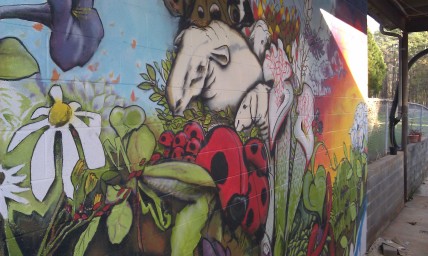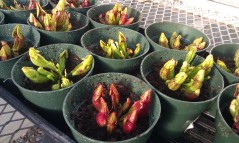Going Dormant
With things moving slower with The Scifund Challenge than expected, I have had to make decisions regarding the plants in order to extend the field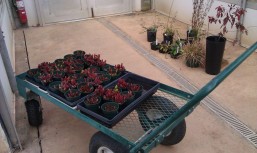 season in the face of dropping temperatures. One of the things that has always fascinated me about pitcherplants is that they take cues from the amount of daylight hours they receive. In the winter when they begin to get less and less exposure to the sun’s rays they enter a period of dormancy that can last for up to three or four months depending on their location. During dormancy the plants just shut down and do not feed or produce new tissue. It is just as well since there are few insects around in winter in most habitats. The fact that the plants shut down based on the amount of day light hours rather than say temperatures is much like the act of hibernation you would find in mammals, which to me, makes my plants all that much cooler.
season in the face of dropping temperatures. One of the things that has always fascinated me about pitcherplants is that they take cues from the amount of daylight hours they receive. In the winter when they begin to get less and less exposure to the sun’s rays they enter a period of dormancy that can last for up to three or four months depending on their location. During dormancy the plants just shut down and do not feed or produce new tissue. It is just as well since there are few insects around in winter in most habitats. The fact that the plants shut down based on the amount of day light hours rather than say temperatures is much like the act of hibernation you would find in mammals, which to me, makes my plants all that much cooler.
This coolness though was recently threatening the integrity of my study however when you consider that my research involves feeding my plants and so I kind I of need them to stay happy and alert and well…not dormant.
So what’s a poor researcher to do? Well I will give you a hint…it involves trickery…and electronics…but mostly trickery and frolic (Okay the trickery is based on science but I frolicked while doing it so I am claiming that one.) Yes, what I am referring to is using a set of specially designed lights referred to as grow lights that are attached to a timer to fool my plants into thinking that the days are not in fact getting shorter; That Mr. Sun is happy in the sky for a full 12 hours each and every day for as long as I need to get things figured out. Soooo…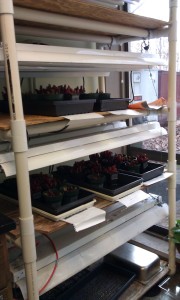
Time to Move to The Grow Lab
Okay, so let me back up for a minute so you can understand a little about how I got to all the frolicking and trickery to begin with. So now that you know something about the behavior of purple pitcherplants, let me tell you a little something about Mother Nature. First off though, know that I have the ultimate respect for this beautiful planet and everything in it as I believe that there is a brilliant design in even the tiniest microcosm of a habitat within a droplet of water in a spider’s web. Therefore understand what I am about to say is said with humor but in complete seriousness, with a side of reverence many a researcher, conservationist and ecologist will understand. I think Mother Nature would get it too.
First and foremost, never trust a weatherman’s forecast and make plans of any sort based on it (and especially not any for ecological research) because Mother Nature works spectacularly hard at making the Earth run the way it is supposed too and trying to act as if we tiny humans are in any way capable of doing a better job is really a slap in the face and will only make your life and everything in it meet with mass resistance from Ms. Nature herself. Case en point: Living in the south, particularly north Georgia from October to March is enough to make anyone think the one at the controls is more than a little bi-polar. Cold.Hot.Freezing.Balmy.Rainy and Dreary. Drought! One day you are wearing a scarf, mittens and Pea-coat paired with your favorite boots while you hunch against a bitter wind and literally the next you’re sporting one of your many retro national park tee shirts, jeans and Tevas and bopping to the iPod while working in the garden in the bright sunshine.  Someday’s I wake up and the first thought that crosses my mind is that between God and Mother Nature, someone lost a bet. Because of this, all good botanists and ecologists, everybody really, knows doing research with plants can be a little frustrating during this time and that it’s just a much better bet to try to get things accomplished during Spring and Summer. Those seasons are really not any more predictable, but for some reason Ms. Nature just seems a little more relaxed…
Someday’s I wake up and the first thought that crosses my mind is that between God and Mother Nature, someone lost a bet. Because of this, all good botanists and ecologists, everybody really, knows doing research with plants can be a little frustrating during this time and that it’s just a much better bet to try to get things accomplished during Spring and Summer. Those seasons are really not any more predictable, but for some reason Ms. Nature just seems a little more relaxed…
I knew this of course when I began my work but you know that little thing called “Murphy’s Law” that states, “If anything can go wrong, it will”? Yeah that essentially applies to most parts of my life and definitely to the project, often in ways that become hugely humorous later…as I laugh and cry and recount all the lessons I have learned along the way…but I digress.
So without the money for the equipment (specifically the pH meter) to continue the study and nothing on the horizon from The Scifund Challenge I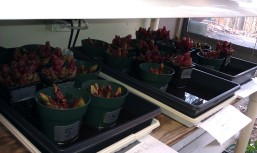 made a decision to move the plants to the Grow Lab. The Grow Lab is exactly what it sounds like, an area specially designed to help plants grow by exposing them to light for a set period of time. By moving the plants I would be able to have them exposed to 12 hours of light on a daily basis, more than enough to trick them into thinking it is still fall for a little while longer, extend the field season and buy myself some time to keep the project going while I figure out what my next steps are.
made a decision to move the plants to the Grow Lab. The Grow Lab is exactly what it sounds like, an area specially designed to help plants grow by exposing them to light for a set period of time. By moving the plants I would be able to have them exposed to 12 hours of light on a daily basis, more than enough to trick them into thinking it is still fall for a little while longer, extend the field season and buy myself some time to keep the project going while I figure out what my next steps are.
Decision Time
The trade-off of course is that the plants are in-doors now rather than the greenhouse, so there are not a whole lot of bugs around and the plants look a little hungry. There have only been two since I have moved them four days ago…I am reluctant to dip into my research supplies (ants) because that will mean I will have to capture more once I get the pH meter and can start the trials (feeding them fire ants too), which might prove difficult as it is much harder to collect insects in the winter, part of why the plants go dormant in the first place.
I could buy insects but even that small expense at this point might be counter-productive if I can’t get the rest of the equipment soon. Additionally another effect of the grow lab is that my plants are growing and it looks like they will soon need to be transplanted into bigger pots. As it is they are already requiring much more distilled water and much more often since they were moved and while not expensive, it does add up for 45 plants. (Distilled water is a requirement of the study primarily because the water at the State Botanical Gardens has such a high pH that it isn’t good for the plants and two I need to remove as many confounding factors as I can as far as things that may affect the health of the plants.)
I never like to end these posts on a bum note and I won’t do that tonight either. I posted on the Scifund Project page that no matter the outcome of the challenge, the project will continue and survive…primarily because I refuse to let it fail, and also because one way or another I am graduating in May and this project will be completed, period. And the good things that are happening because of this project (Bog in a Box, Bog Conservation) will continue way beyond graduation, the Scifund Challenge or the University of Georgia because doing this has changed both me and conservation for the better and changed how I will leave my mark on this wonderful, beautiful planet.
Thanks to all my wonderful supporters, especially to new friends like Todd Palmer of the The Palmer Lab who just recently donated to the project. I couldn’t have done it without all of you! Still want to help? You still can by logging on to the project page and clicking the Fuel this project link.

